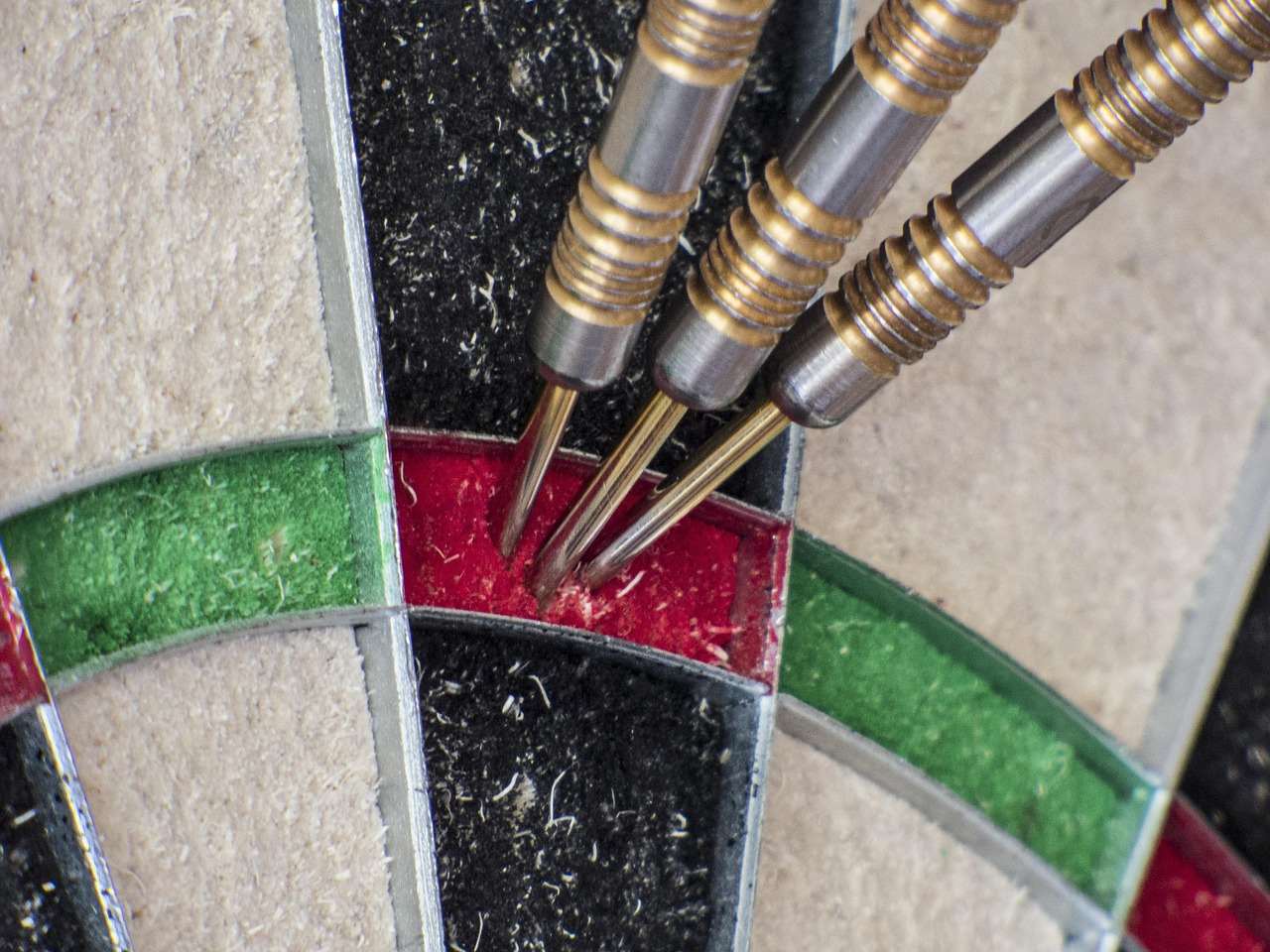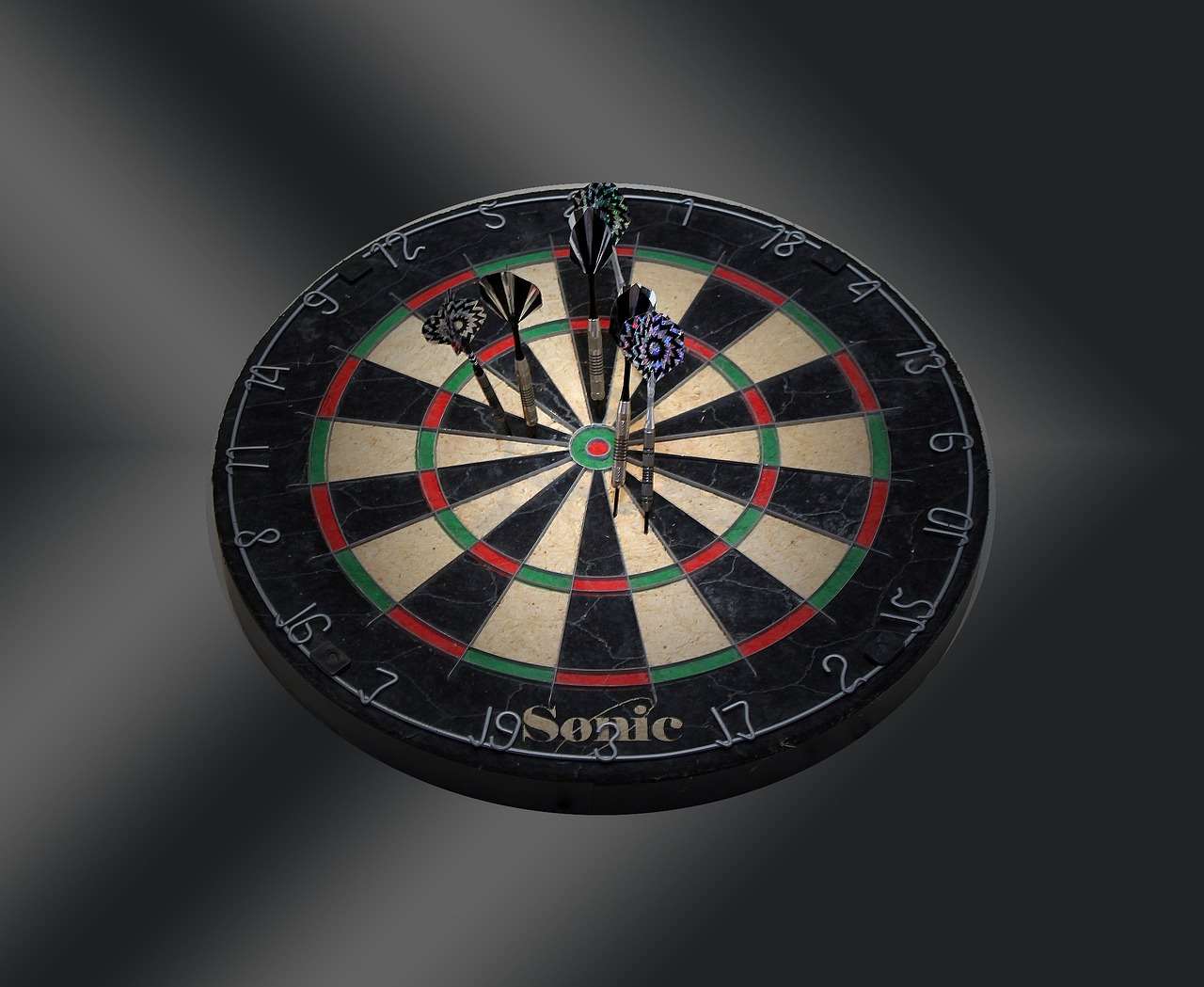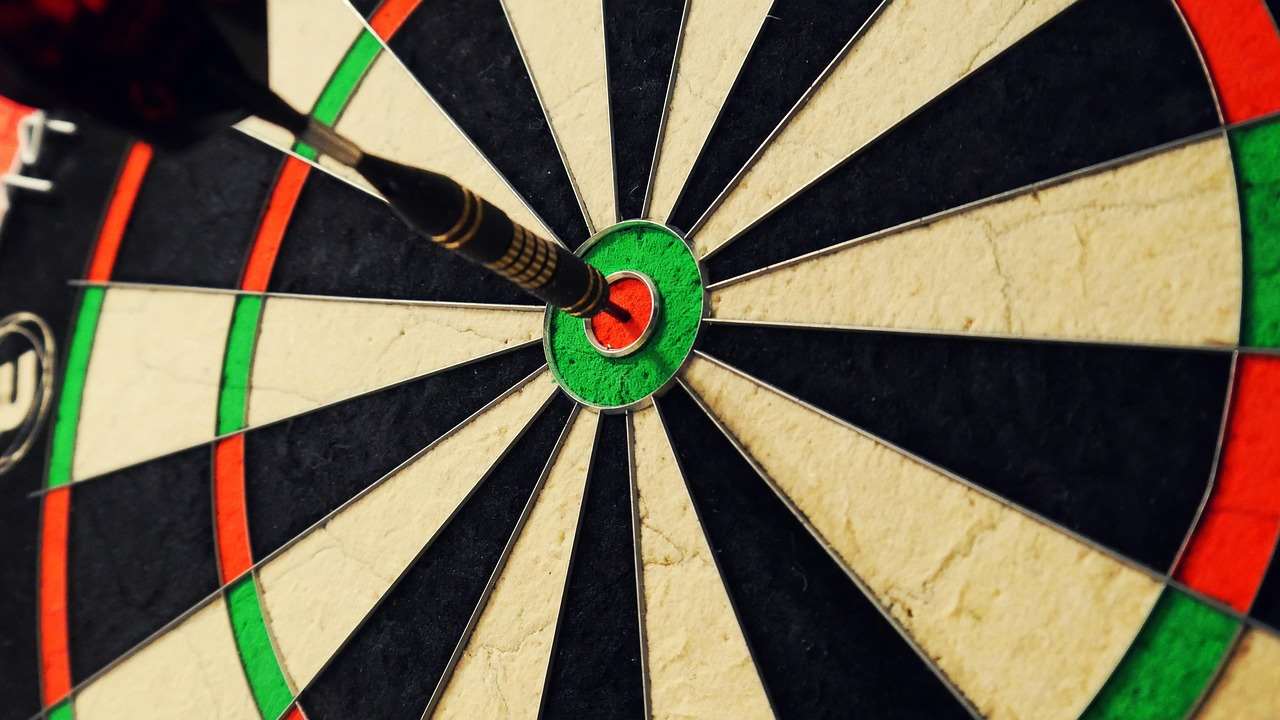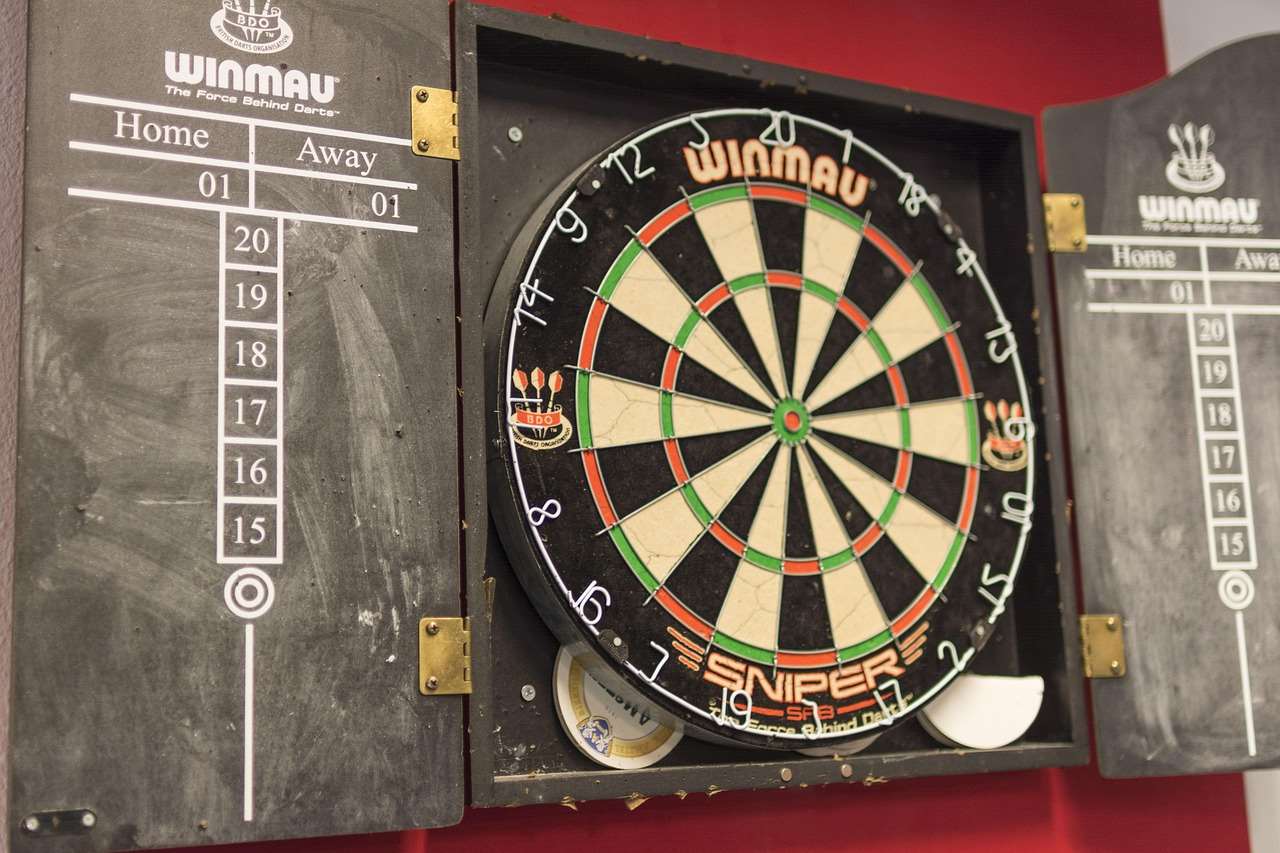So, what are dart boards? Simply put, they’re targets used in the game of darts, consisting of a circular board with numbered segments. This article will explore everything from the different types of dart boards available to tips for improving your game, helping you understand this popular pastime better.
⚠️ Still Using Pen & Paper (or a Chalkboard)?! ⚠️
Step into the future! The Dart Counter App handles all the scoring, suggests checkouts, and tracks your stats automatically. It's easier than you think!
Try the Smart Dart Counter App FREE!Ready for an upgrade? Click above!
Dart boards are more than just a simple target; they’re a gateway to a world of skill, strategy, and social interaction. The basic concept is straightforward: throw darts at the board, aiming for the highest scoring segments to achieve the highest points total. But behind the simple premise lies a universe of variations and nuances. From the traditional bristle board to the modern electronic dartboard, each type offers a unique playing experience. We’ll delve into the specifics of these variations, the materials they’re made from, their sizes, and the importance of proper setup.
What Are Dart Boards and How to Choose the Right One for You
Understanding what are dart boards requires examining the different types available. The most common types are bristle dart boards and electronic dart boards. Bristle dart boards, made from sisal fibers, are known for their durability and the satisfying “thunk” they produce when hit by a dart. They offer a more traditional and challenging game, requiring precision and consistency. Electronic dart boards, on the other hand, are easier to use, often featuring automated scoring, multiple game options, and even sound effects. They’re a great choice for beginners and those who appreciate the convenience of technology. The choice between the two largely depends on your personal preference and budget. Consider factors such as your skill level, available space, and desired features. Do you prefer the classic feel of sisal, or the convenient digital scoring of an electronic board? This decision is key to enjoying your dart-playing experience fully.

The size of a dart board is standardized in professional play, but variations exist in the home market. Understanding the standard dimensions ensures compatibility with official regulations and promotes a fair gameplay experience. Choosing the right size depends on the available space in your game room or designated area. Remember to leave enough space around the board for a comfortable throwing distance. Improper spacing can lead to frustration, accidents, and an overall less enjoyable experience. The correct throwing distance is vital for consistent performance. A improperly spaced dartboard is a common cause of many frustrated dart-players.
The Anatomy of a Dart Board: Understanding the Segments and Scoring
A standard dart board features 20 numbered segments arranged in a circular pattern. Each segment is further divided into inner and outer rings, allowing for variations in scoring. The bullseye, or the central circle, is usually worth 50 points. A ring surrounding the bullseye, called the bull, is worth 25 points. The other segments are worth their respective numbers, with the outer ring doubling the score and the inner ring tripling it. Understanding this scoring system is fundamental to mastering the game. The strategic placement of your darts on the board significantly impacts your total score. Even slight variations in accuracy can affect the final score, highlighting the importance of aim and precision. Learning to consistently hit high-value sections is a key skill for any aspiring darts player.

Beyond just understanding the numerical value of each section, experienced players learn to anticipate the bounce and behaviour of darts. A perfectly thrown dart lands straight into its target, but less-than-perfect throws can cause the dart to ricochet off the board. This bounce can drastically change the final score. A dart that hits close to the edge of a triple can easily bounce into a single or even off the board entirely. Practicing and understanding this effect is a large factor in being a proficient dart player.
Different Types of Dart Boards: Bristle vs. Electronic
While we’ve touched on this, it’s worth emphasizing the differences between bristle and electronic dart boards. Bristle dart boards, the traditional choice, are typically made from sisal fibers, offering a durable and consistent playing surface. Their natural fibers allow for darts to stick securely but maintain sufficient give, meaning that the damage caused to the board will spread out across the fibers instead of a small single point. However, bristle boards require more maintenance, including the occasional need for repair or replacement of worn areas. Electronic dart boards, on the other hand, offer automatic scoring, multiple game variations, and even built-in sound effects. They’re lower maintenance but may not provide the same satisfying feel as a traditional board. Electronic dart board costco is just one place where you can find great examples of this type.
Setting Up Your Dart Board: Essential Tips for Optimal Gameplay
The placement and setup of your dart board are crucial for an enjoyable and consistent gaming experience. The recommended height for the bullseye is 5 feet 8 inches from the floor, but you should adjust according to your height and throwing style. Ensuring proper lighting and a clear throwing area are also essential factors. A cluttered area not only reduces your accuracy, but can lead to hazardous situations due to dart throws. Make sure that your surroundings are clear of any potentially obstructive objects. This will allow for a cleaner, safer, and more accurate game.
For those wondering what are dart boards in the context of a tournament, the standardized dimensions and height are strictly enforced. This consistency guarantees fairness and a level playing field for all participants. The meticulous adherence to these standards ensures the integrity of the competition, highlighting the importance of such regulations in competitive environments.

Consider the type of wall you are using; some materials require additional measures for proper dart board installation. A heavier board may require stronger mounting hardware and supports for preventing structural damage to the wall. To avoid any potential issues it is a good idea to research what you will be needing. Depending on the type of board and its weight you might need to use additional materials in order to prevent any accidents.
Maintaining Your Dart Board: Tips for Longevity
Regular maintenance will extend the life of your dart board. For bristle boards, this involves removing damaged bristles, using a bristle brush, and occasionally using a cleaning solution. Electronic dart boards require less maintenance but regular cleaning is still recommended. Always check for and resolve any issues that might arise, such as loose components or malfunctions, especially with your electronic dart boards. Maintenance keeps your board playing its best and prevents potential issues down the line. This is particularly important for electronic boards to maintain the sensitivity of the technology.
Improving Your Game: Tips and Tricks for Dart Success
Mastering the game of darts requires practice, but there are techniques that can significantly improve your accuracy and scores. A consistent grip, proper throwing motion, and mental focus are all key elements. Practicing different throwing styles and finding what works best for you is paramount. Many players find that they only start hitting the numbers consistently when they begin to practice their form.
Many players find that the hardest part about darts is maintaining consistent accuracy. Practice can help reduce this variance and build muscle memory. Even seasoned players will benefit from practicing, as it can help you correct your throws and fine-tune your game. The key to consistent scores is not just being able to throw well, but to be able to repeat the throw accurately, time and time again.
For beginners, start with aiming for the larger numbers, working your way to the smaller ones. Focus on your technique rather than solely on the score, making corrections to your posture, grip, and throwing motion. Regular practice sessions will yield significant improvement, leading to a more enjoyable and successful dart game experience.

Beyond the physical aspects of the game, mental focus and concentration are crucial. Minimize distractions during gameplay and maintain mental composure. Stress and tension can negatively impact performance. Stay focused on the task at hand, aiming each throw at your target with precision and intent. A relaxed and focused player tends to perform better overall. For further tips, you might want to consider checking out our article on how to dart throw.
Common Mistakes to Avoid
One common mistake for beginners is gripping the dart too tightly. This can affect the throw’s accuracy and consistency. Using the right dart for you is also important, and understanding your preferred weighting, length, and shape can drastically improve your game. You should also pay attention to your posture and body position. A slouched or uneven stance reduces accuracy and can lead to inconsistent throws. Which darts player hits the most 180s demonstrates the importance of perfecting these techniques.
The Social Side of Darts: A Game for Everyone
Darts is a game enjoyed by people of all ages and skill levels. It’s a fantastic social activity, promoting camaraderie and friendly competition. Playing with friends and family is a great way to relax, have fun, and bond over a shared pastime. It can be played in a casual setting or as a more competitive pursuit. From pub leagues to professional competitions, the world of darts offers something for everyone.
Numerous leagues and competitions exist for all skill levels. Engaging in these can not only improve your game, but also allow you to connect with a larger community of enthusiasts. The social aspect of the game is what makes darts so unique and enjoyable. To keep track of scores you may want to use a Mobile dart scorer.

Whether you’re a seasoned pro or just starting, the competitive aspect of the game always keeps it engaging. From local pubs and clubs, to national and international tournaments, the level of play is as varied as the players. Regardless of your skill level, there is always a place for you in the darts world. Whether you’re interested in casual competition with friends, or more formal league matches, finding a local darts group is a great way to improve your skills and have fun.
Many darts players choose to specialize in certain aspects of the game, focusing on areas where they excel and developing expertise in specific aspects. Whether you’re a high-scoring bullseye master or an expert at triple-20s, developing your own strategy and perfecting these skills ensures that you get the most out of this dynamic game. In fact, the intricacies of game play, scoring, and strategy often lead players to specialize in their areas of expertise. You might be interested in learning 9 dart finish how many are necessary for a perfect game.
Conclusion: Embracing the World of Dart Boards
Understanding what are dart boards is just the first step to embracing this engaging and social game. From choosing the right board and setting it up correctly, to mastering throwing techniques and enjoying the social aspects, the world of darts offers endless possibilities. So, grab some darts, gather your friends, and prepare for hours of fun and friendly competition. Remember, practice makes perfect, and every throw is a step closer to becoming a darts master. Don’t hesitate to explore the different aspects of the game, from learning about darts flights k flex to checking out the results of the darts championship 2022, or keeping up to date with darts wk live if you are serious about the game! And if you’re looking to hone your skills, learning about darts score list and their value will certainly be of great assistance. Finally, don’t forget to check out if are darts a sport to further your understanding of this exciting pursuit.
Whether you’re interested in casual games or competitive leagues, remember to consult online resources, local clubs, or experienced players for further advice and guidance. Happy throwing!
Hi, I’m Dieter, and I created Dartcounter (Dartcounterapp.com). My motivation wasn’t being a darts expert – quite the opposite! When I first started playing, I loved the game but found keeping accurate scores and tracking stats difficult and distracting.
I figured I couldn’t be the only one struggling with this. So, I decided to build a solution: an easy-to-use application that everyone, no matter their experience level, could use to manage scoring effortlessly.
My goal for Dartcounter was simple: let the app handle the numbers – the scoring, the averages, the stats, even checkout suggestions – so players could focus purely on their throw and enjoying the game. It began as a way to solve my own beginner’s problem, and I’m thrilled it has grown into a helpful tool for the wider darts community.